Kakuni or Japanese Braised Pork Belly is the most succulent and fork-tender meat simmered in a delicious sweet-savory sauce. Cook it low and slow for an irresistible bite that simply melts in your mouth!
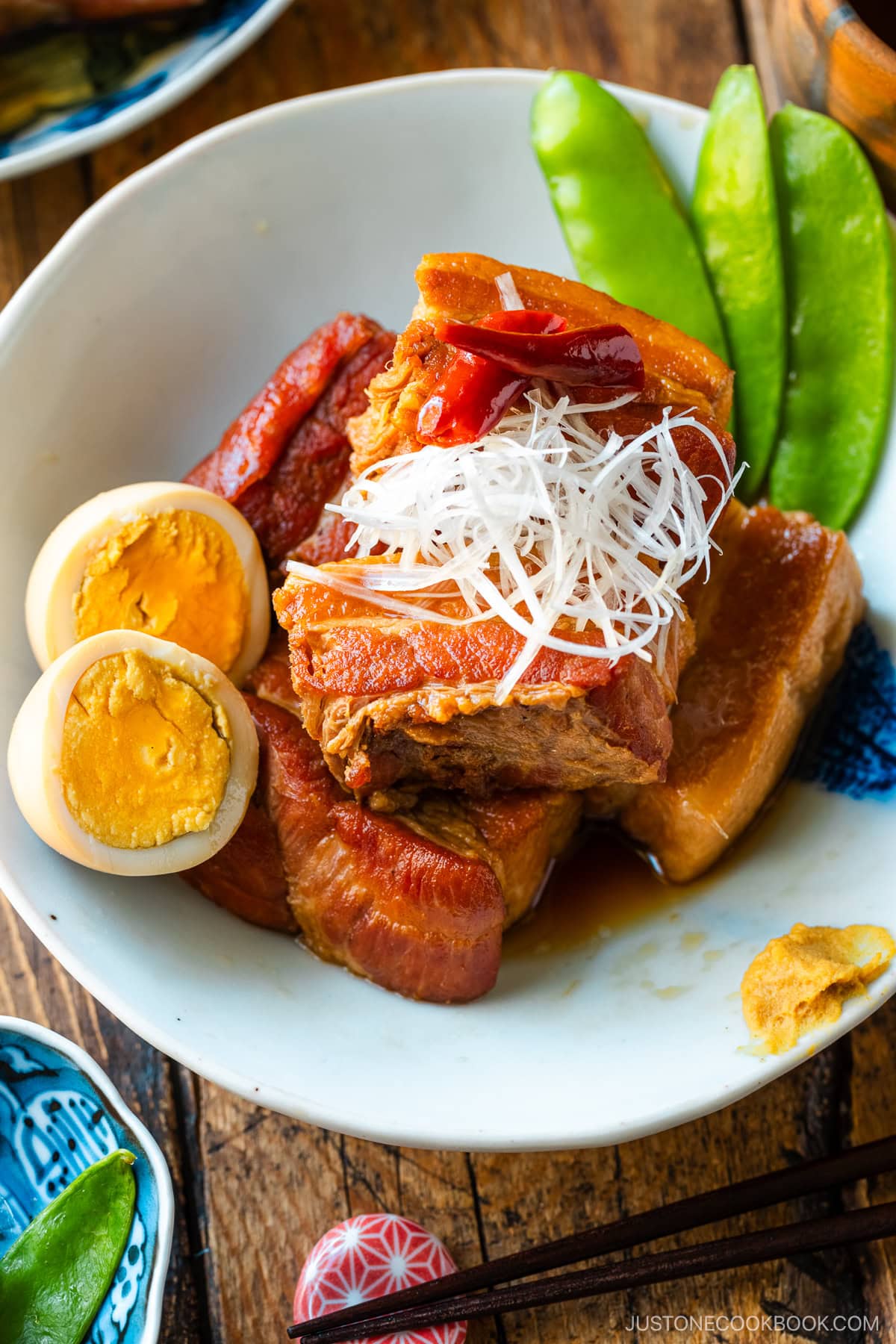
My family loves the super-tender and succulent texture of Japanese braised pork belly called Kakuni (角煮). I wholeheartedly agree with them. Even though this dish is quite rich, there is something about it that I cannot resist!
In today’s Kakuni recipe, I’ll share the key to making the most fork-tender and delicious pork belly that you can imagine. While it takes a few hours of cooking time, it’s easy to do in any home kitchen with standard cookware and simple ingredients.
Table of Contents
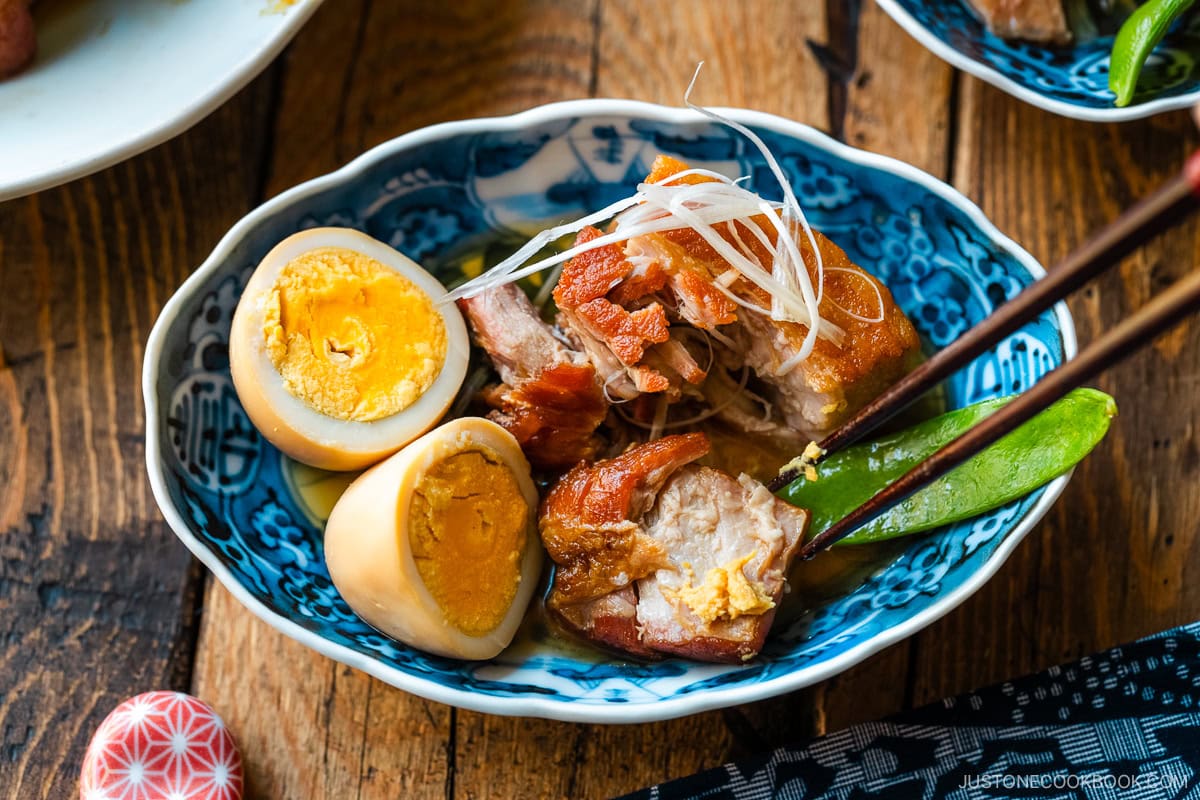
What is Kakuni?
Kakuni (角煮) is skinless pork belly that’s slowly simmered (ni), cut into squares (kaku), and braised in a salty-sweet seasoning liquid. A local specialty of the southern island of Kyushu, Japanese all over the country enjoy this succulent and tender kakuni drizzled with its delicious savory sauce as a standalone dish, on a rice bowl, tucked into steamed buns, or on noodle soup.
Japanese braised pork belly traces back to the Chinese dish dong po rou introduced to Okinawa and Nagasaki during Japan’s isolation period (1639–1853). Palace chefs of Okinawa’s Ryukyu Kingdom transformed it into the court dish rafute. In Nagasaki, it became the banquet dish toba-ni served in shippoku (卓袱, hybrid) cuisine. From these two foods, Kakuni eventually adapted into the delicious dish that we know today.
Why This Kakuni Recipe Works
While I’ve tried many ways to cook it, this method makes the best kakuni!
- No pressure cooker required — My method uses standard cookware, so you don’t need any special equipment. Although the total time for this recipe is a bit long, the results are worth it!
- Simple ingredients — You just need pork belly and common Japanese seasonings and aromatics.
- Fork-tender texture — The secret? An initial slow-cook of 3 hours.
- Meal-prep friendly — Make two batches and freeze some for future meals. The flavor improves with several hours of resting, making it a perfect make-ahead dish!
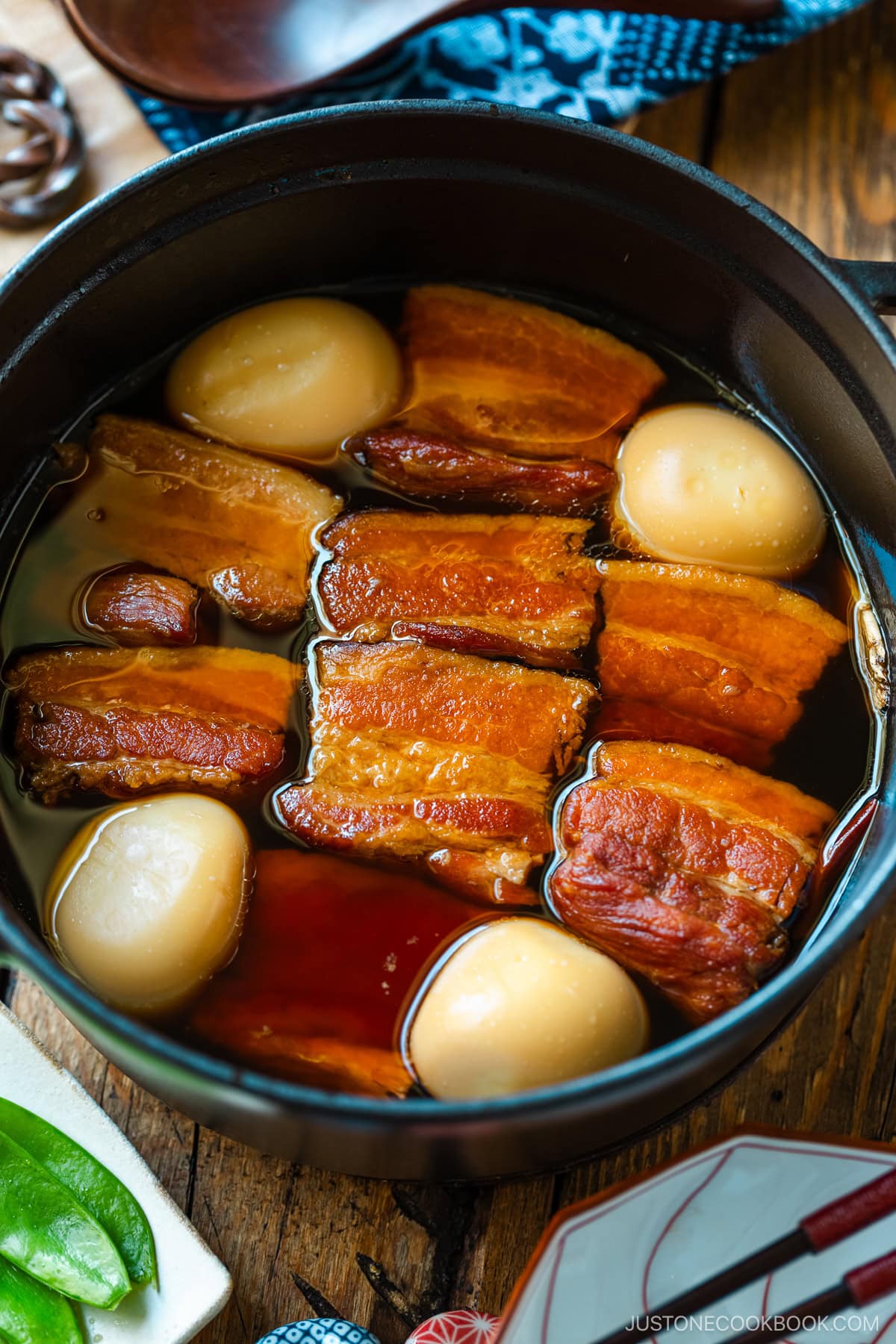
Ingredients for This Recipe
You’ll need just simple ingredients and common Japanese seasonings:
- pork belly — skinless; ask your butcher to remove the skin
- Tokyo negi — for the initial simmering (the green part) and the garnish (the white part)
- knob of fresh ginger — for aroma and flavor
- sake — to get rid of the pork’s odor
- dashi, mirin, sugar, soy sauce, chili pepper — to season the sweet-savory braising liquid
- large eggs (optional) — soft-boiled and simmered in the seasoning liquid
- snap peas (optional) — for garnish and color; or use green beans or other vegetables
Substitution Tips and Variations
You can vary the ingredients and flavors in creative ways:
- If you can’t find pork belly, try pork shoulder. You’ll need a fatty cut to keep the meat moist and tender. While shoulder has a lower fat content, it can produce a somewhat similar texture and flavor.
- Change the seasonings and aromatics any way you like. Try Chinese-inspired spices and aromatics like star anise, five-spice powder, and/or garlic in the braising liquid. For a lighter color and taste, reduce the soy sauce and add some salt instead.
- Replace the Japanese sake in the simmering liquid with Chinese rice wine.
- Experiment with different garnishes. Instead of snap peas, try green beans, spinach, bok choy, okra, or daikon. Substitute the slivered Tokyo negi with scallions or green onions, or try slivered fresh ginger or grated daikon instead.
- Serve with your favorite condiment. While I suggest shichimi togarashi (Japanese seven spice), you could also serve it with pungent and spicy karashi (Japanese hot mustard).
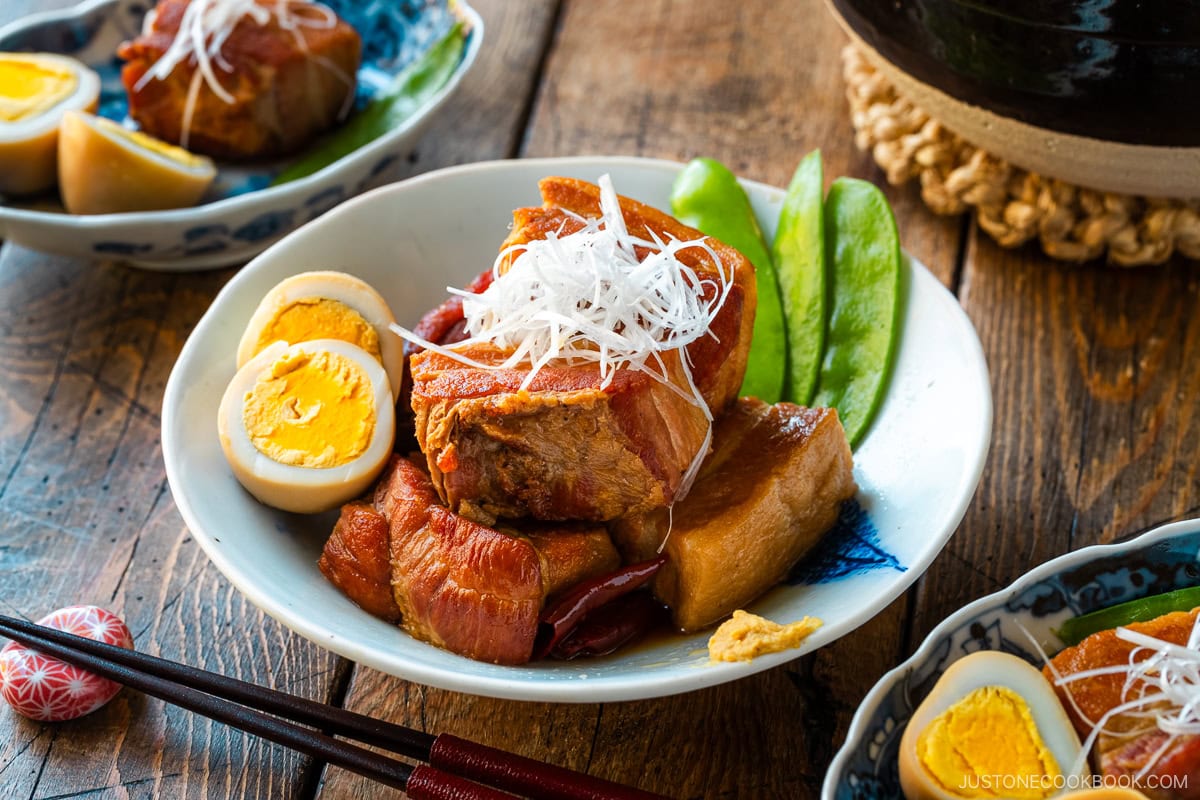
How to Make the Best Kakuni
Gentle, slow cooking is the key to a melt-in-your-mouth texture.
- Sear: Brown all sides of the pork belly pieces in a heavy skillet.
- Slow-cook: Boil the meat in a large pot with water, sake, the green part of the negi, and half of the ginger slices. Skim the scum and fat from the surface, and place a drop lid (otoshibuta) on top. Simmer gently, uncovered, for 3 hours.
- Braise: Cut into 2-inch pieces. Place the pork belly cubes in a medium pot and add all the seasonings except for the soy sauce. Simmer for 30 minutes, then add the soy sauce and optional soft-boiled eggs. Simmer for another 30 minutes and serve.
Recipe Tips and Techniques
- Sear the surface of the meat until golden brown before boiling to draw out excess fat and lock in the flavor. Add oil to the pan and sear it fat side down to help the fat render faster.
- Highly recommend getting this splatter shield to avoid the oily mess.
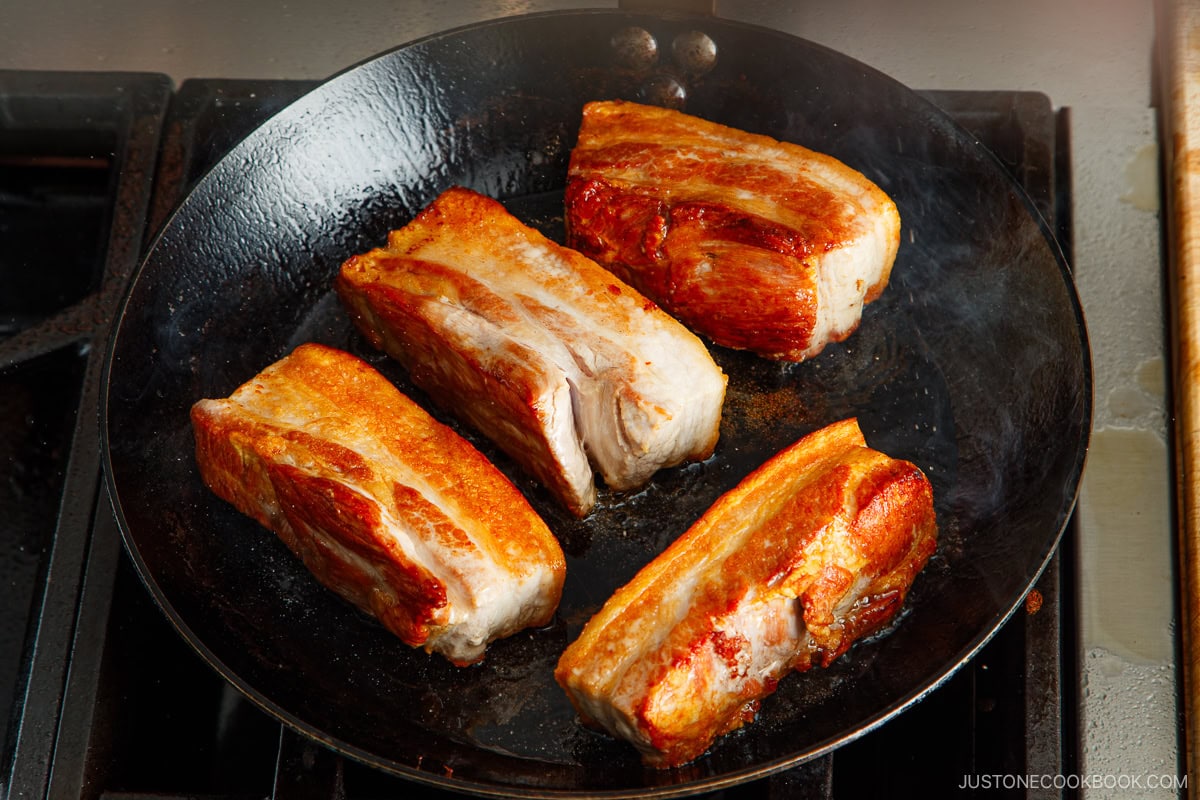
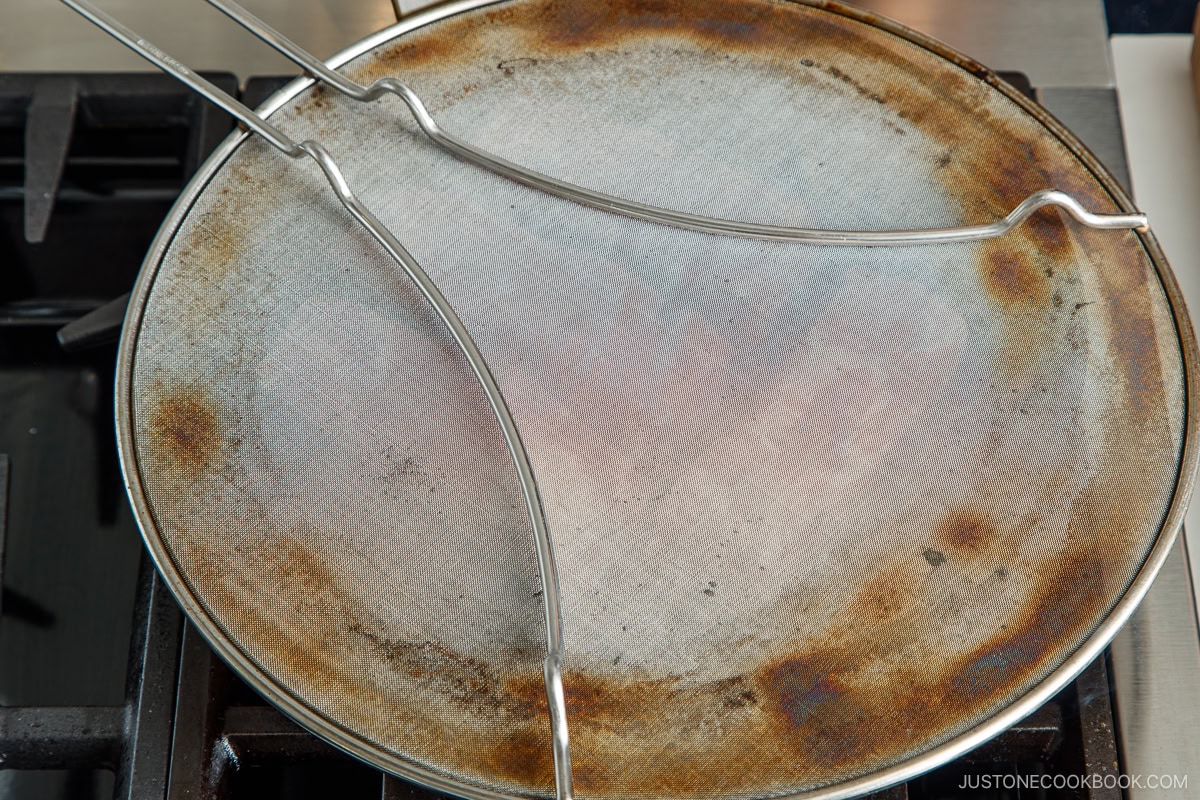
- Boil the meat to keep it juicy and remove excess fat and scum. Fully submerge the meat in the cooking liquid using an otoshibuta (drop lid) so it doesn’t dry out. Add more water if necessary.
- Slow-cook over low heat for really tender pork belly, and cook it for at least 3 hours on a gentle simmer for the most succulent results. The meat will become tough if you use medium heat or medium-high heat.
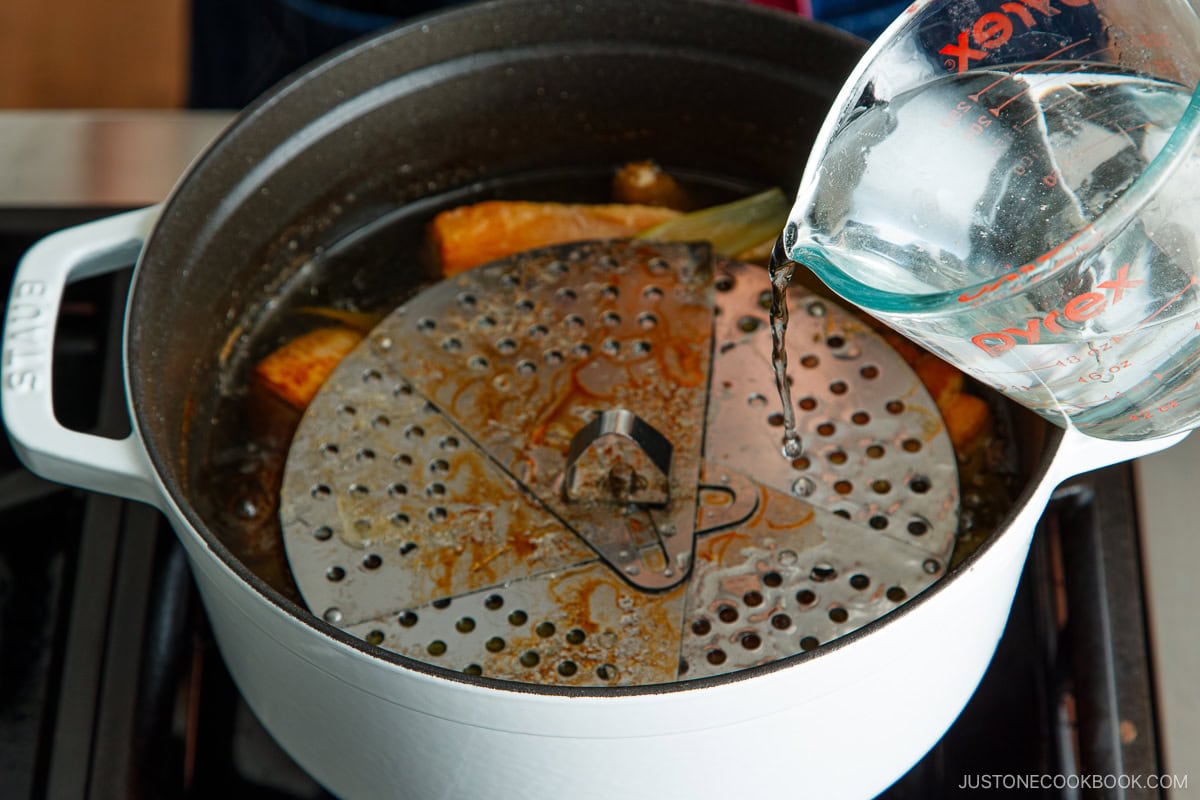
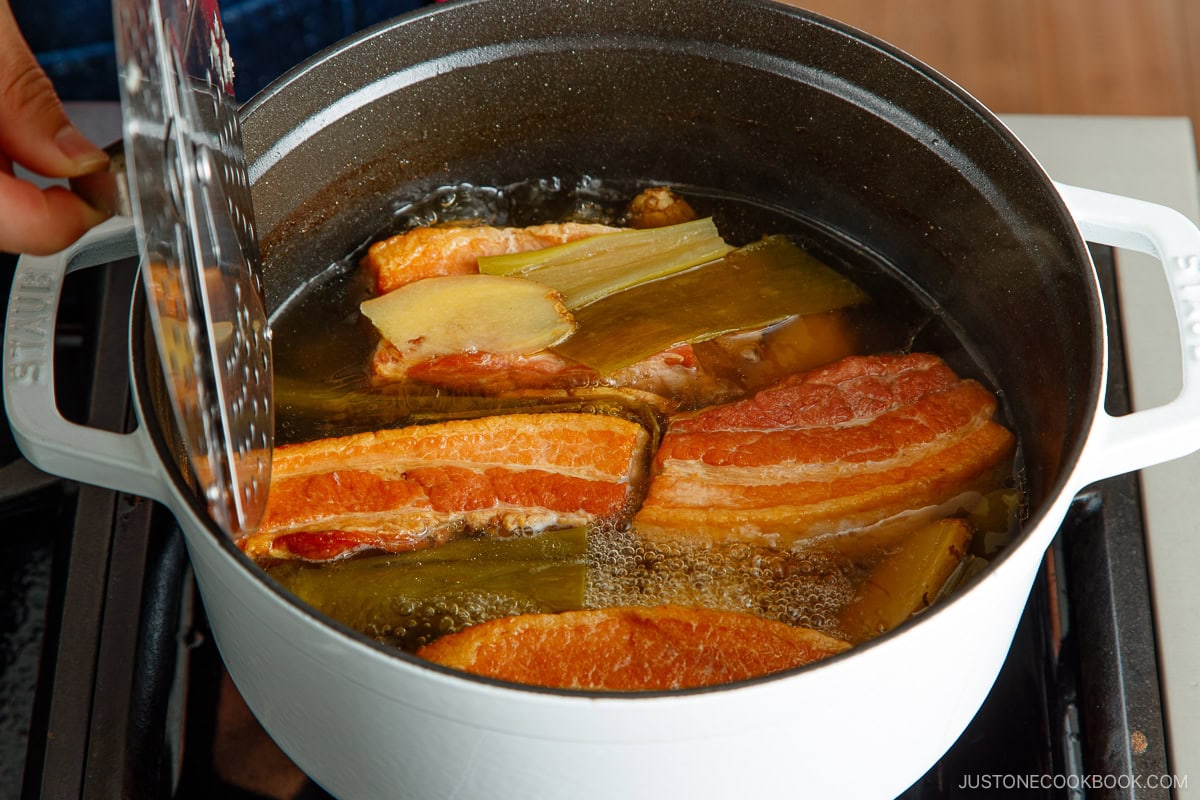
- Season the pork belly with all the condiments, except for soy sauce. We add the soy sauce later on to keep the meat from cooking in it a long time and becoming salty.
- Rest the meat for several hours before serving it to enhance the flavor (optional). While you can eat it right away, Kakuni tastes best when you gradually cool it in the braising liquid so it absorbs more flavor. Gently reheat it to serve.
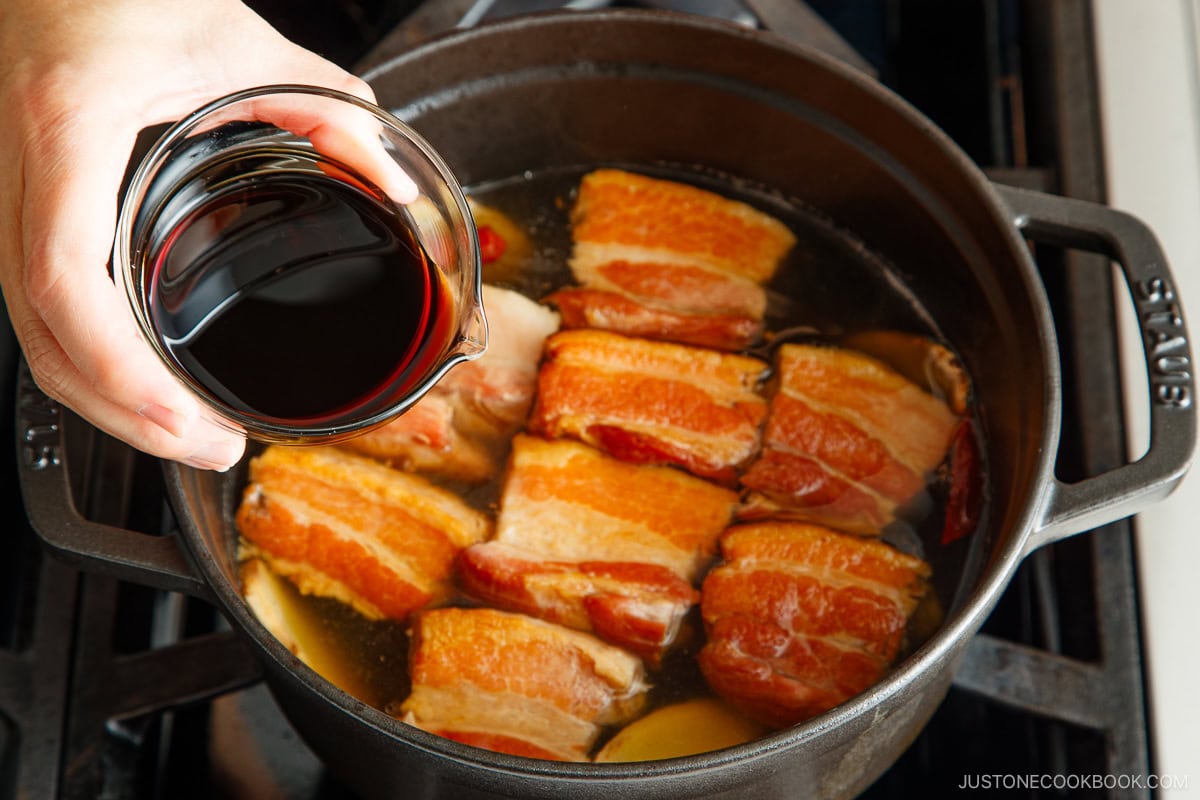
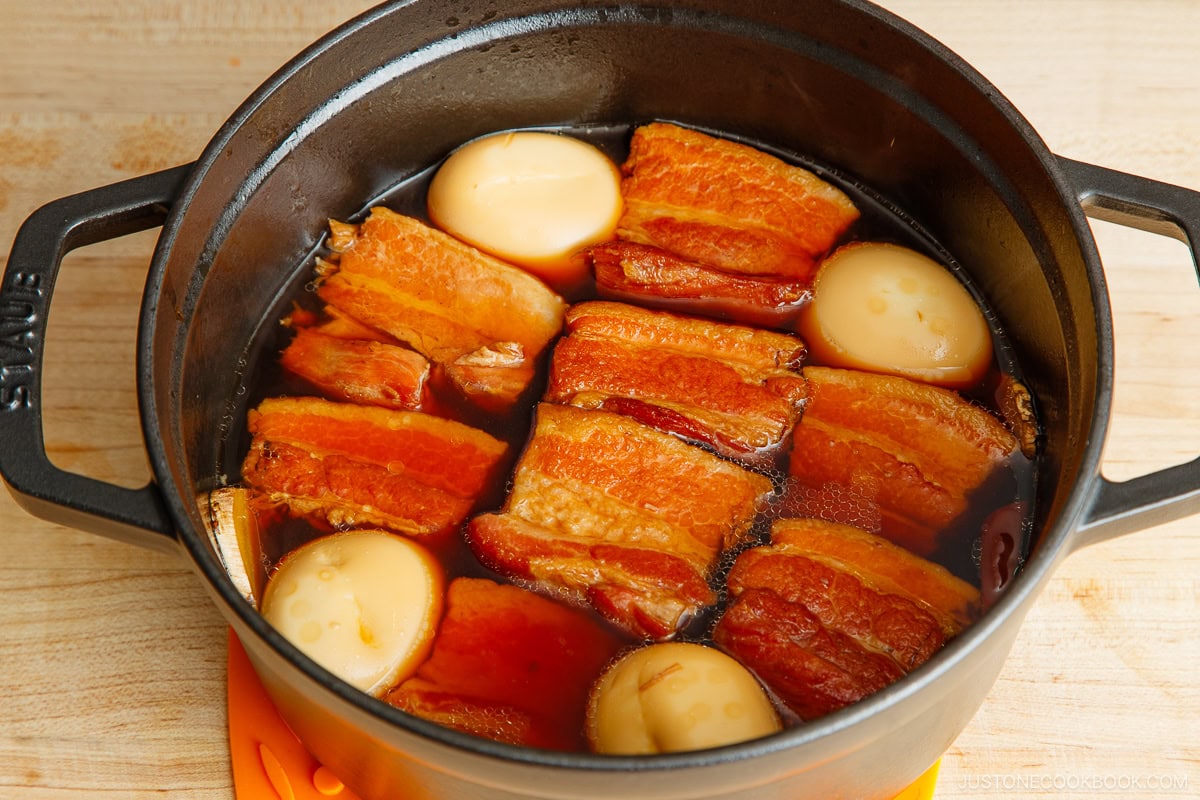
How to Store
- To Refrigerate: Keep the leftovers in an airtight container and store in the refrigerator for up to 3-4 days and in the freezer for a month.
- To Reheat. For the best results, use low heat on the stove to gently reheat the Kakuni in a pot with its braising liquid.
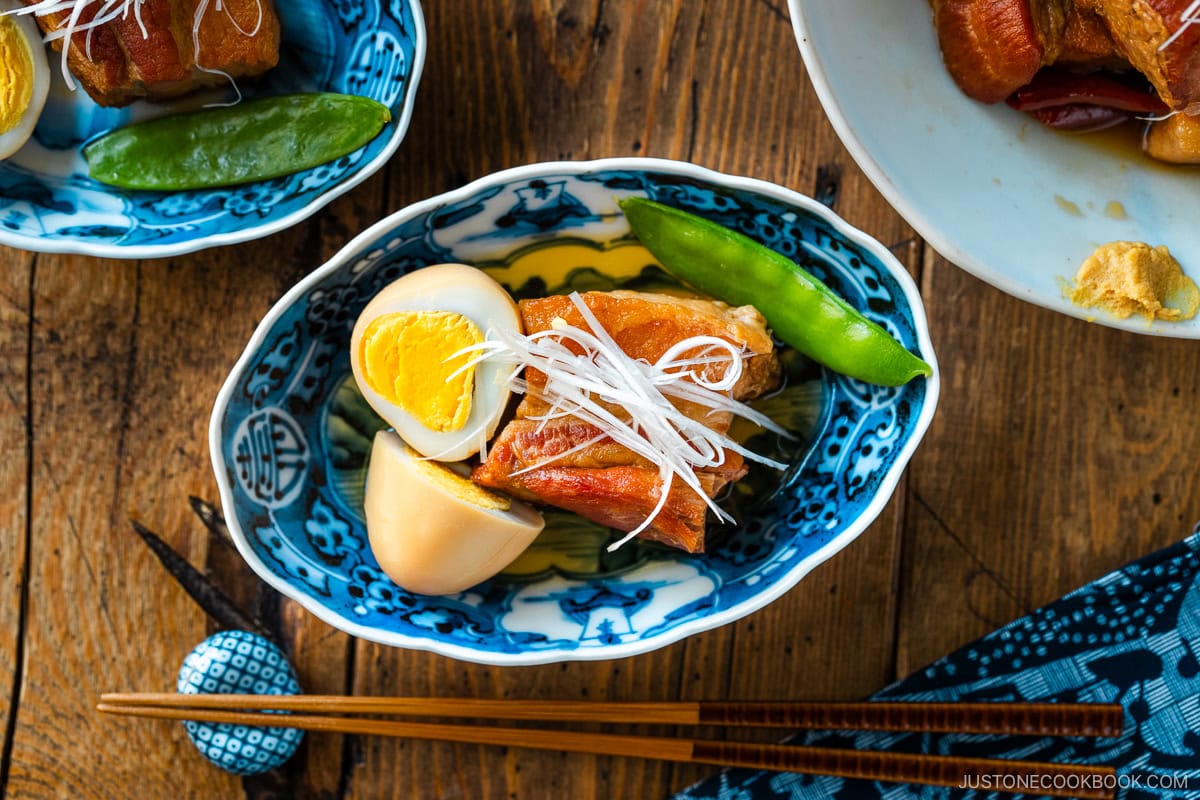
FAQs
Can I use beef or chicken?
You can use beef ribs or chicken thighs and cook them similarly. Let us know if you try this!
Can I use another cut of pork?
To make kakuni, you’ll need a fatty piece of pork to stay moist and tender. While it is not as fatty as pork belly, pork shoulder can provide a similar texture and flavor. This is a typical substitute for pork belly as it can be used interchangeably in most recipes following the same instructions.
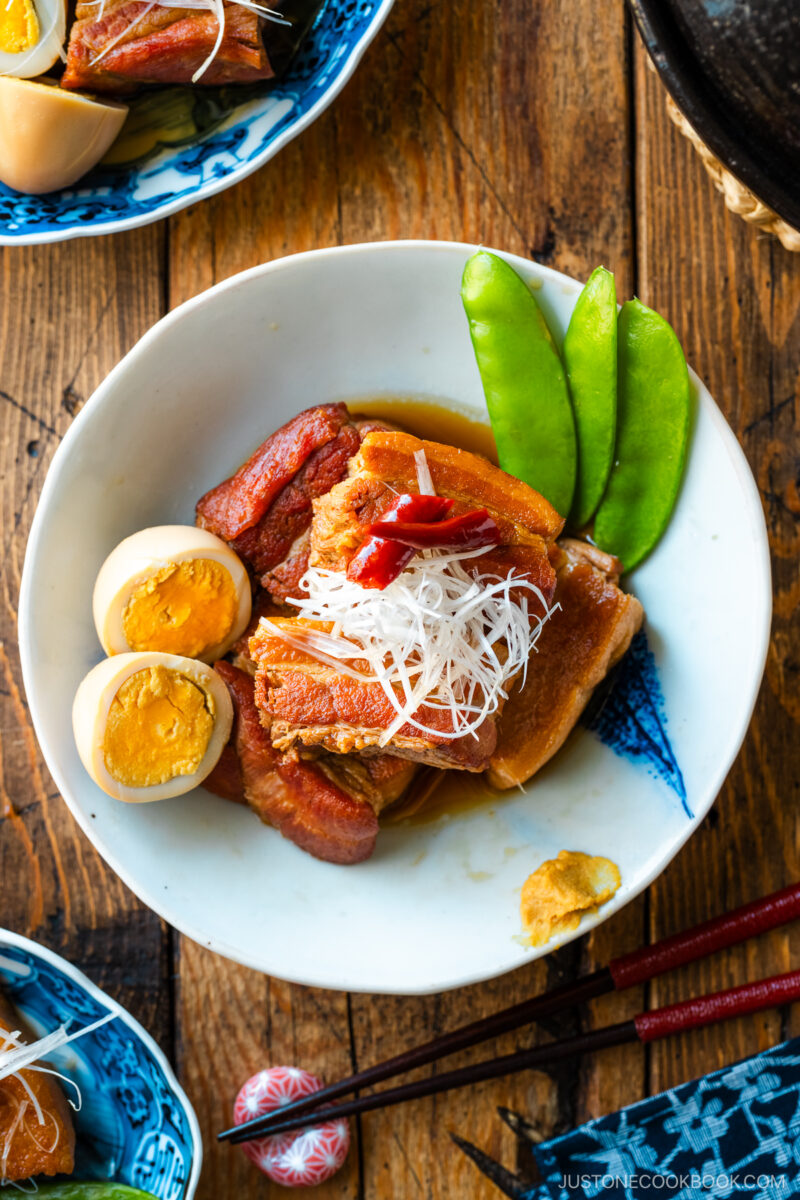
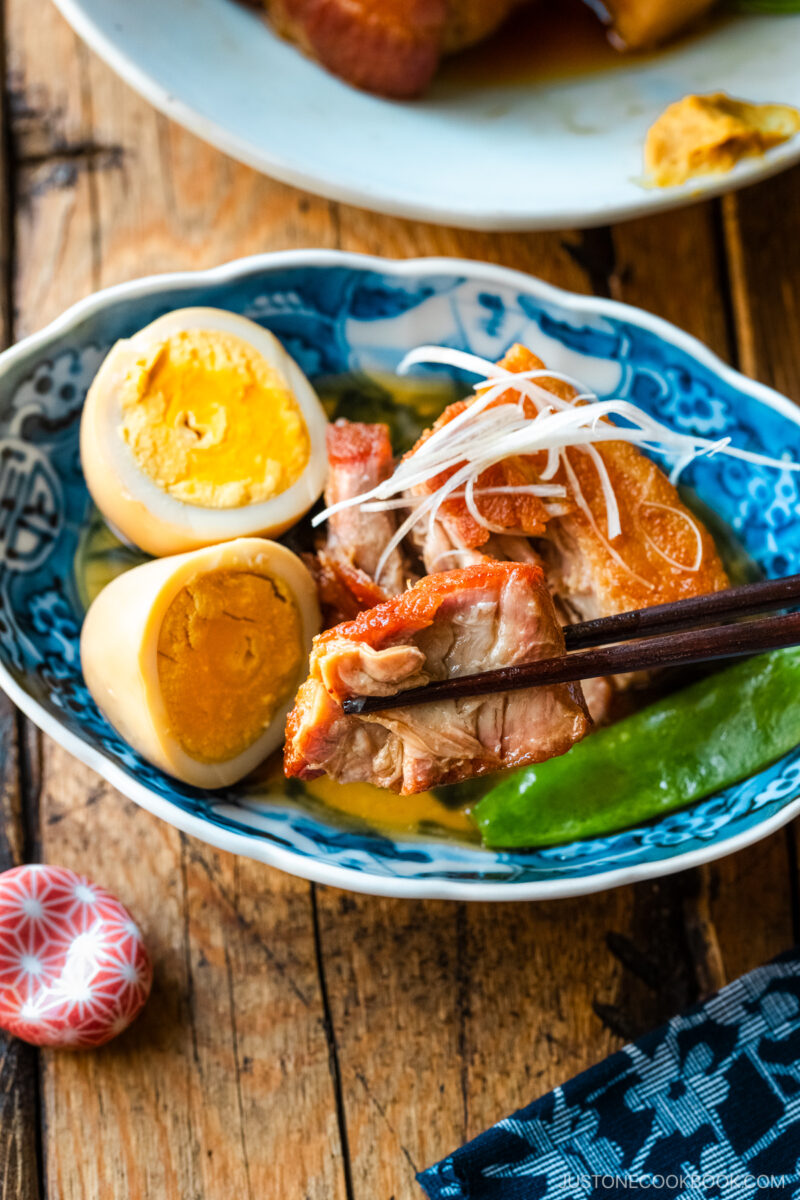
How to Serve Kakuni
- Main dish: Serve with Shrimp Fried Rice or steamed rice; Glass Noodle Soup or Egg Drop Soup; and Spinach Ohitashi, Green Bean Gomaae, or Spicy Japanese Pickled Cucumbers
- Rice bowl: Butadon or Katsudon
- Ramen noodle soup: Miso Ramen, Shoyu Ramen, or Shio Ramen
- Udon noodle soup: Kake Udon
- Sandwich or buns: In steamed buns (use my Nikuman post) or in a Japanese sandwich like Katsu Sando
- Noodle dish: Hiyashi Chuka or Tsukemen
- Rice dish: Chashu Fried Rice
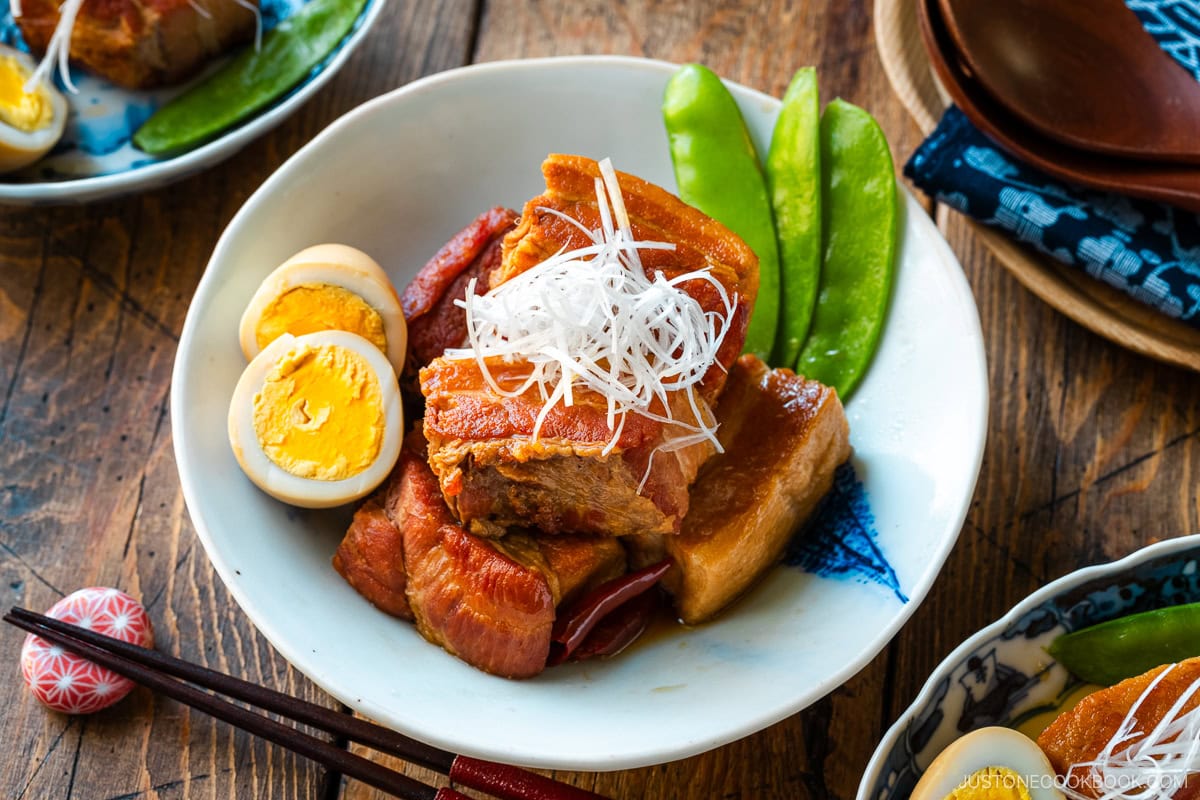

Kakuni (Japanese Braised Pork Belly)
Video
Ingredients
- 1 Tokyo negi (naga negi; long green onion) (or several green onions/scallions)
- 1 knob ginger (2 inches, 5 cm; unpeeled; divided, for slow cooking and braising)
- 1⅔ lb pork belly (or up to 1¾ lb, 790 g for this batch of seasonings; skinless; ask your butcher to remove the skin)
- ½ Tbsp neutral oil (for searing)
- ¼ cup sake
- 4 large eggs (50 g each w/o shell) (optional; cold from the refrigerator)
- 5 snap peas (optional, for garnish; or green beans)
For the Seasonings
- 1 dried red chili pepper (optional)
- 2½ cups dashi (Japanese soup stock) (use standard Awase Dashi, dashi packet or powder, or Vegan Dashi)
- ¼ cup sake
- ¼ cup mirin
- ¼ cup sugar
- ¼ cup soy sauce
For Serving
- shichimi togarashi (Japanese seven spice) (optional, to taste)
Instructions
- Gather all the ingredients. I made quick dashi using a dashi packet (it only takes 3 minutes). Leave the eggs in the refrigerator until ready to use.
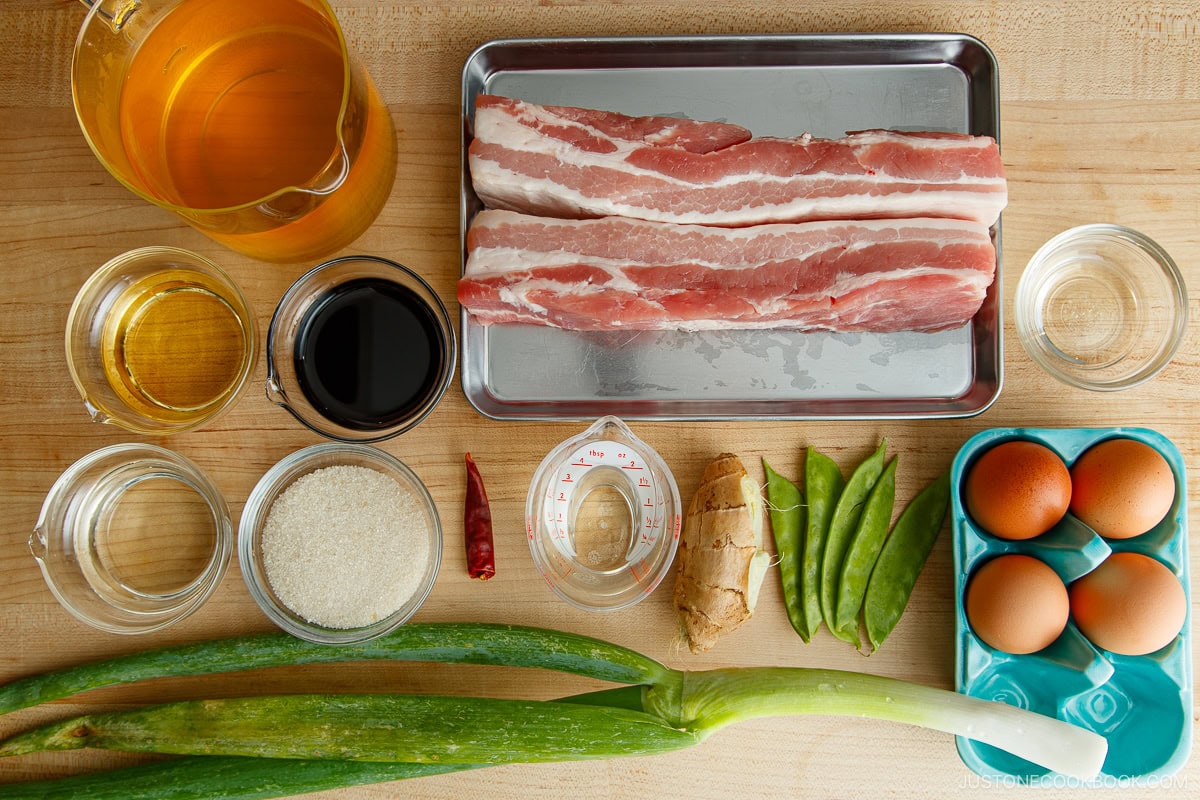
To Prepare the Aromatics
- Cut 1 Tokyo negi (naga negi; long green onion) in half to separate the green and white parts. Cut the green part into 2-inch (5-cm) pieces. Set aside the white part to make Shiraga Negi later for garnish (see how in To Serve below).
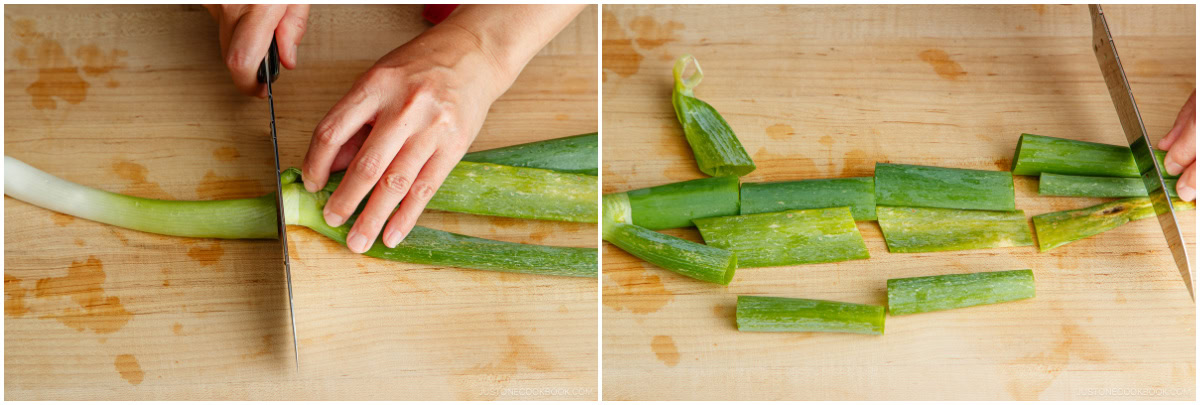
- Cut 1 knob ginger (unpeeled) into thin slices. Divide; set aside half for slow-cooking the pork and the other half for braising.
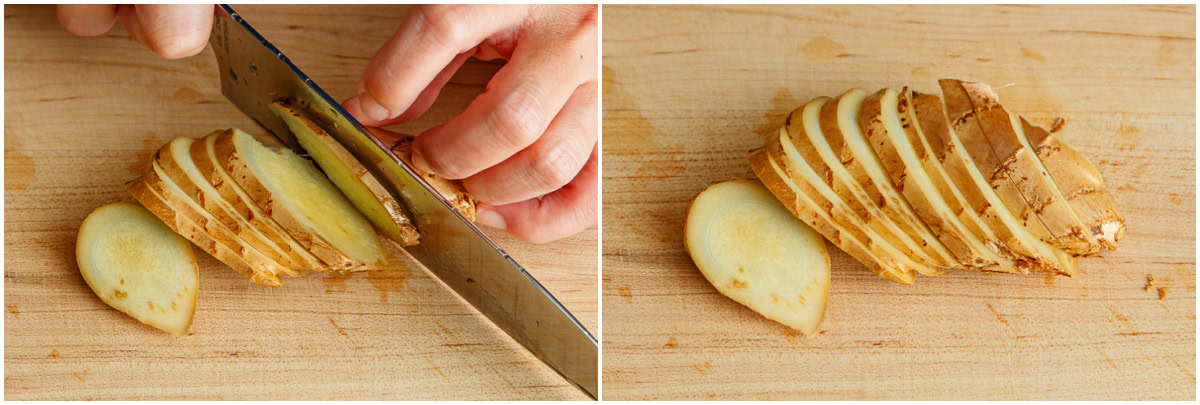
To Sear the Pork Belly
- Cut 1⅔ lb pork belly strips into shorter blocks that will lie straight when placed in a large pot later (I use a 4 QT Staub). If your pork belly is already in smaller blocks, you don't need to cut it. To sear, heat a heavy skillet over medium-high heat. When it‘s hot, add ½ Tbsp neutral oil. Tip: Using the oil helps render the pork's fat faster.
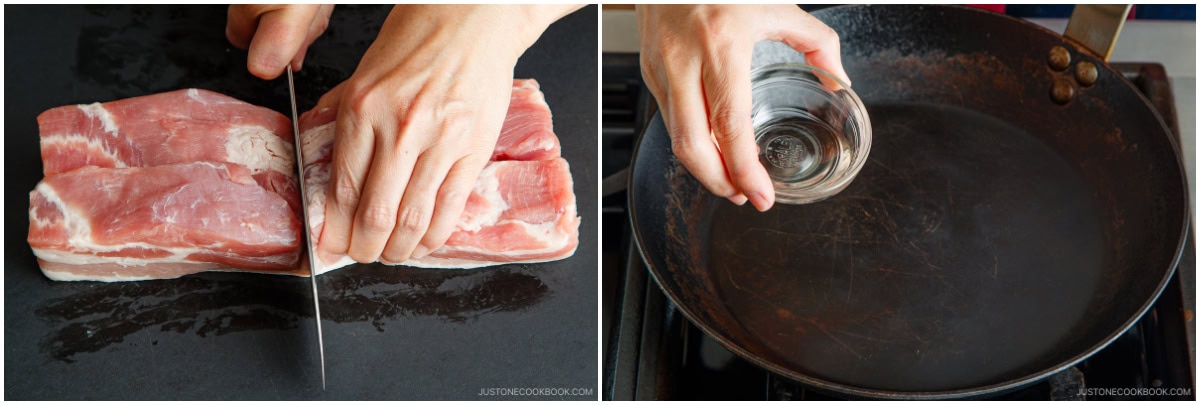
- Place the pork belly fat side down in the hot skillet. (Do not overcrowd the pot. Sear in batches if you're doubling the recipe.) To prevent oil splatter, you can use a splatter screen. Tip: Searing the surface of the meat before boiling helps draw out excess fat and lock in the flavor.
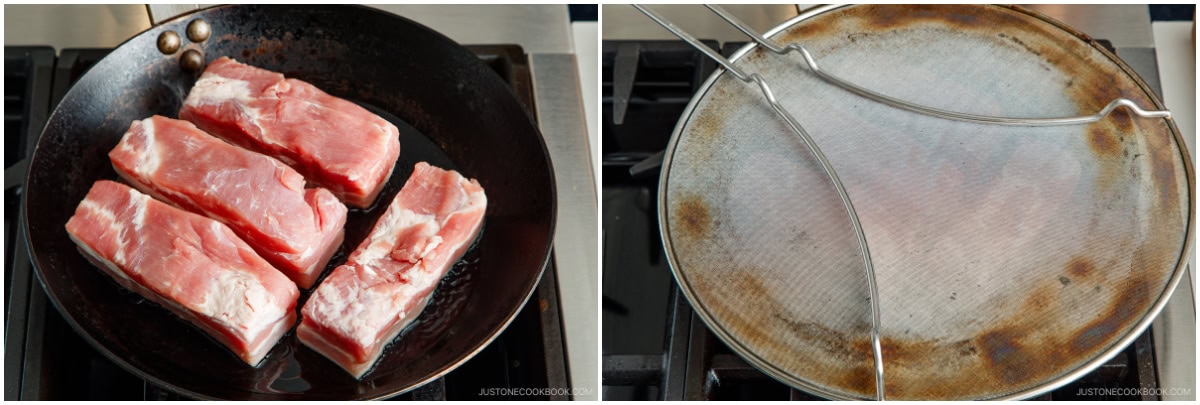
- Sear the meat until all sides are nicely browned, about 2–3 minutes per side.
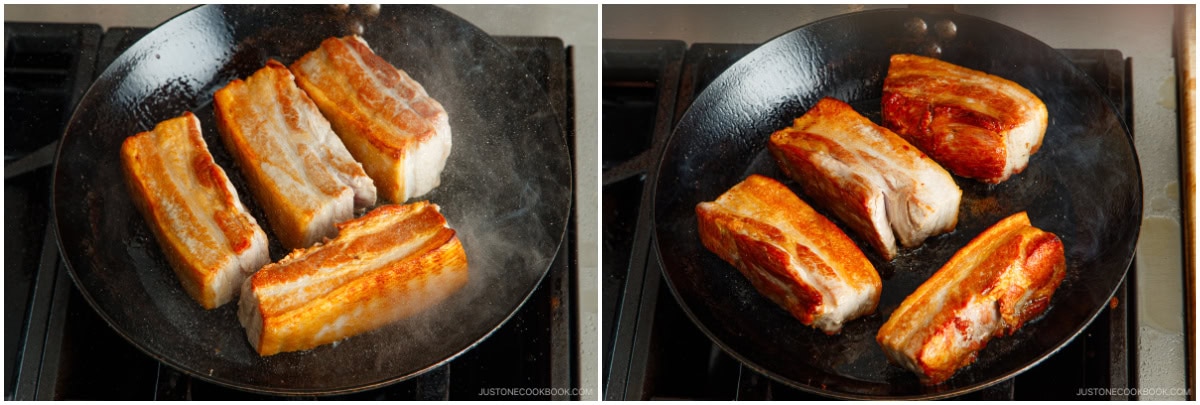
- Transfer the seared pork belly pieces to the large, heavy-bottomed pot. Lay them straight and in a single layer.
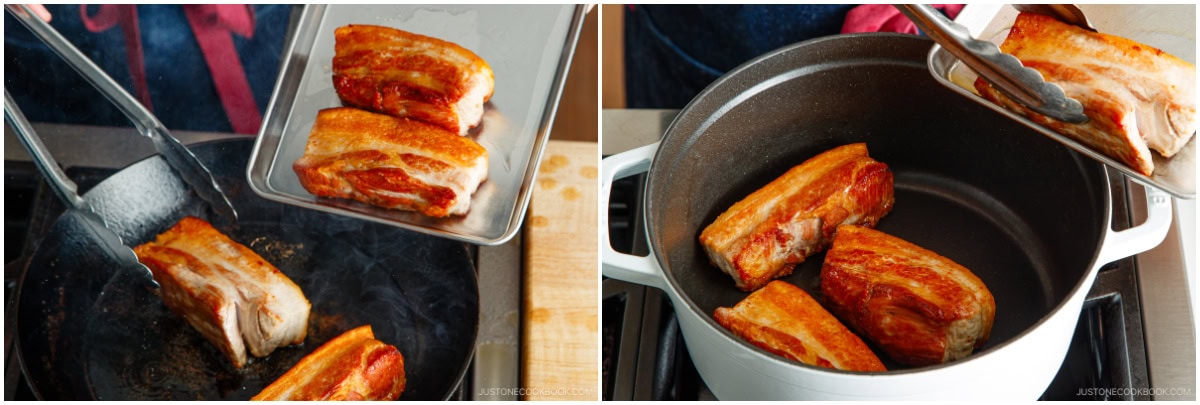
To Slow-Cook the Pork Belly (2½–3 hours)
- To the pot, add ¼ cup sake and enough water to cover the meat. To start off, I added 1.5 QT or 1.5 L water for a single batch of the recipe; however, if there's enough room in your pot, add 2 QT or 2 L of water.
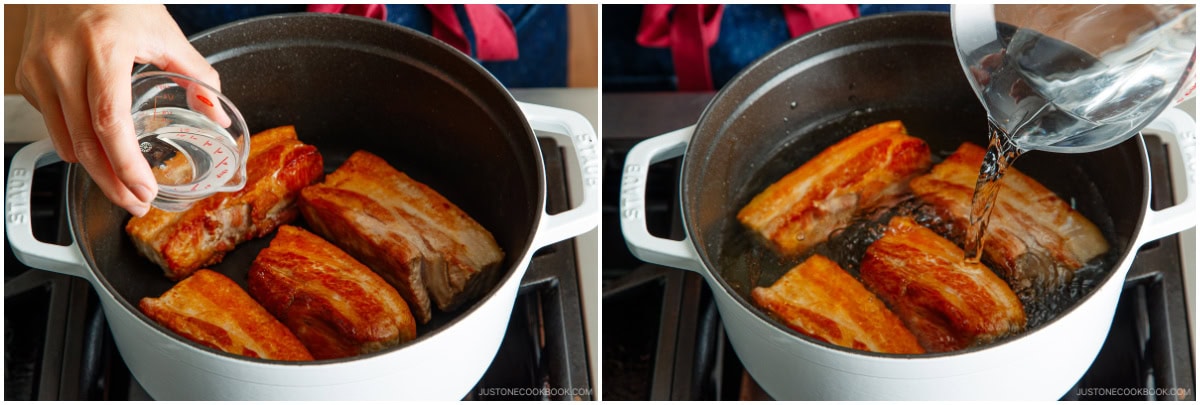
- Add the green part of the negi and half of the sliced ginger (save the other half for braising later). Bring it to a boil over medium heat. Tip: Boiling the meat removes the excess fat and scum while keeping the meat juicy.
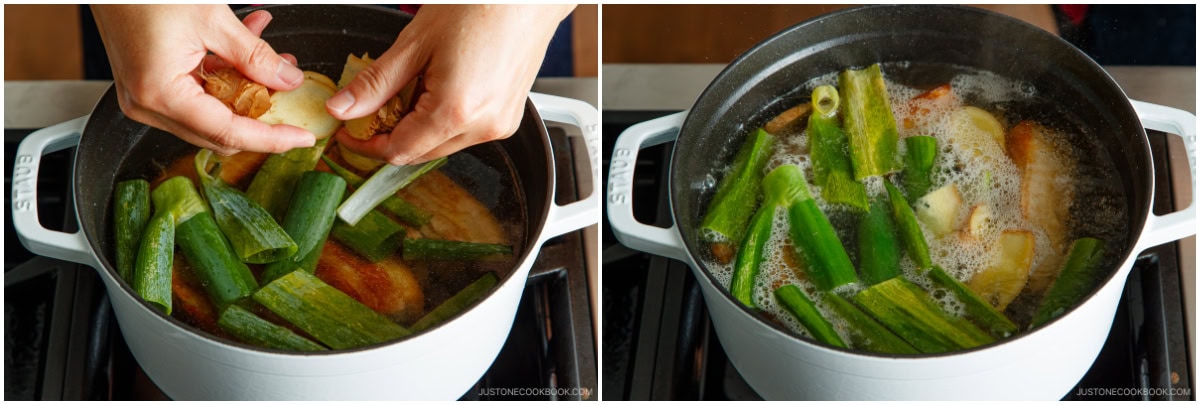
- Skim the scum and fat with a fine-mesh skimmer, and then reduce the heat to a simmer. Place an otoshibuta (drop lid) directly on top of the pork belly. You can buy an otoshibuta on Amazon or make one with aluminum foil following my post on How To Make Otoshibuta. Cook, uncovered, on a *gentle simmer*, for 3 hours. Leave off the pot lid so the unwanted odor goes away. Tip: I cannot emphasize enough that slow, gentle cooking is the key. If you cook on strong heat, the meat will become tough.
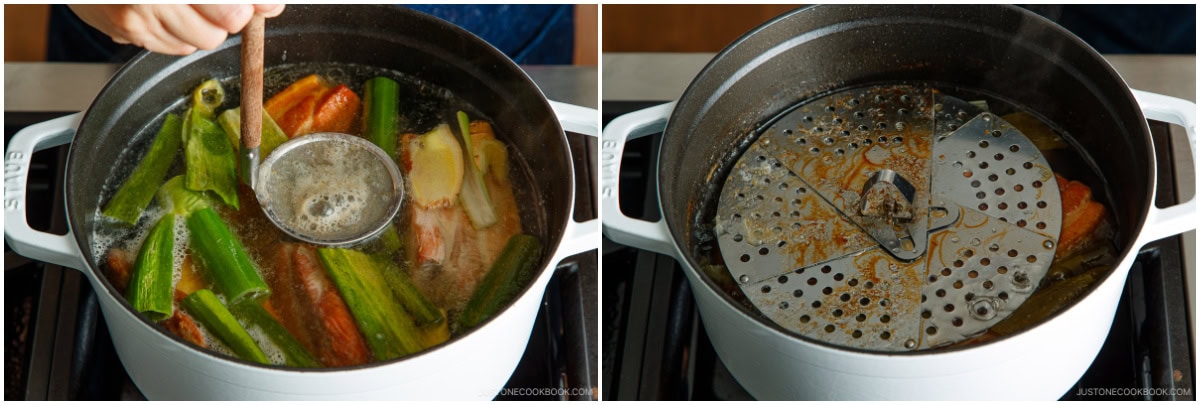
- When the liquid is running low, add more water or hot water (I added another 0.5 QT or 0.5 L) to the pot so the meat remains submerged at all times. Tip: Make sure the meat is not exposed, or else it will become dry.

To Prepare the Optional Eggs and Snap Peas
- Meanwhile, boil enough water in a medium saucepan so the eggs will be completely submerged when added. Remove 4 large eggs (50 g each w/o shell) from the refrigerator. Gently lower the cold eggs into the boiling water using a fine-mesh skimmer. Set a timer for 6½–7 minutes and soft-boil them on medium-low heat.
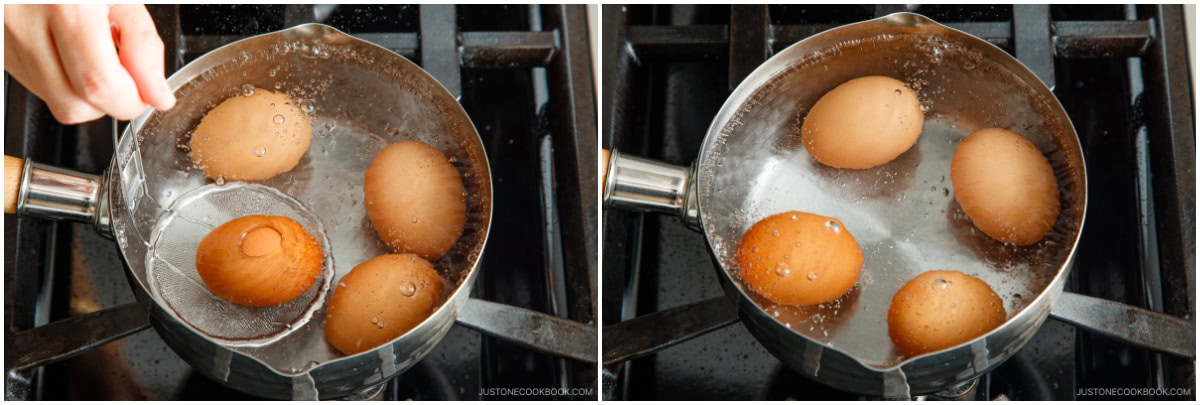
- As soon as the timer is up, transfer the eggs to a bowl of iced water to stop the cooking. Let them cool, peel them, and set aside.
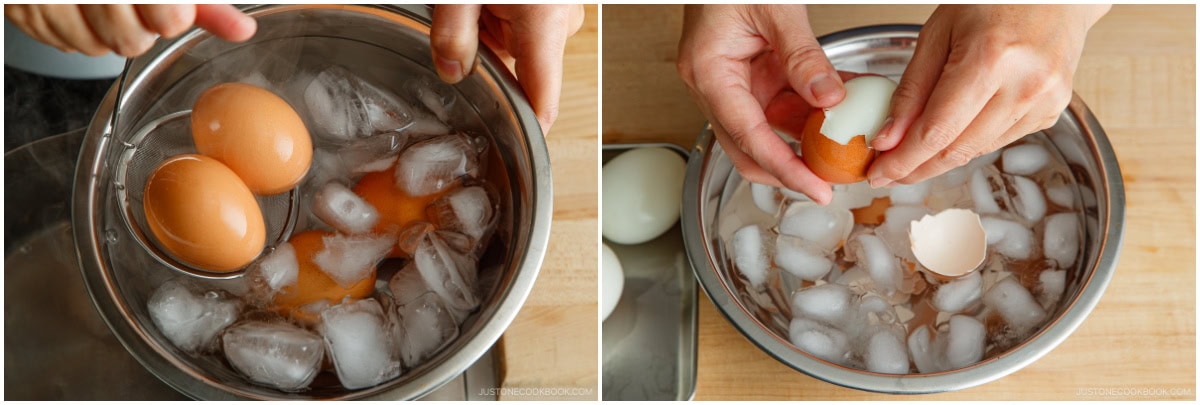
- Bring a small amount of water in the same pot to a boil. Remove the tough strings from 5 snap peas and add them to the boiling water.
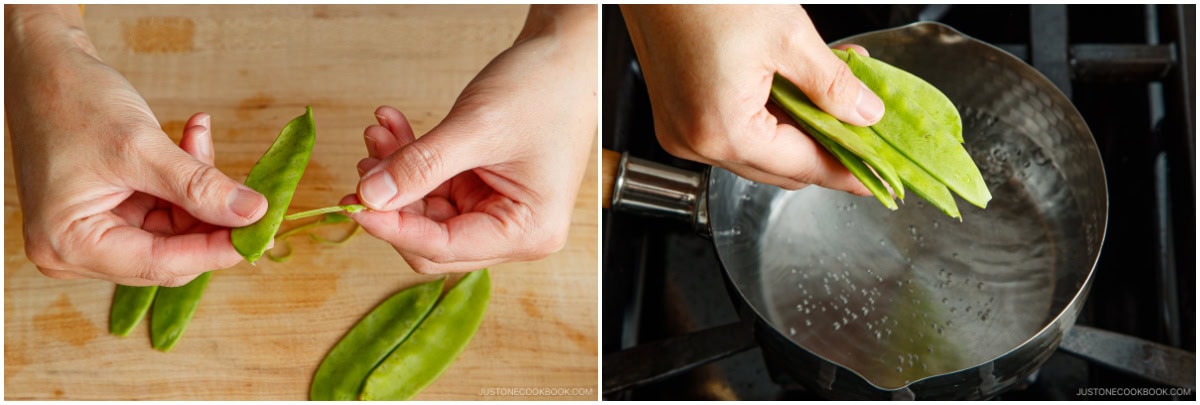
- Blanch them until tender, about 1½–2 minutes. Set aside until ready to serve.
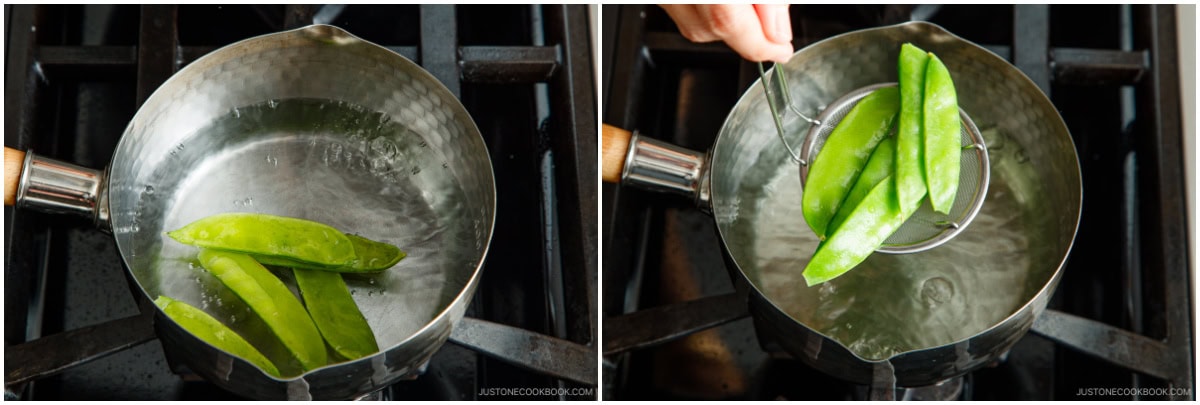
To Braise the Pork Belly (1 hour)
- After cooking for 3 hours, remove the otoshibuta (drop lid) and check the meat for tenderness. Tip: For really tender pork belly, cook for at least 3 hours and add more water as needed to keep the meat fully submerged.
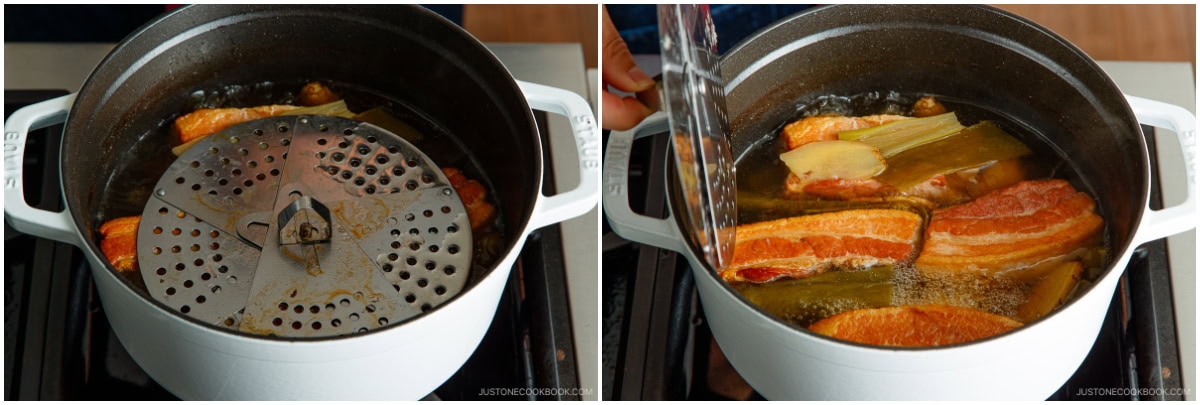
- Remove the pork belly to a tray or plate. If you'd like, you can strain and reserve the cooking liquid as a stock for other recipes. Let the liquid sit in the fridge and skim off any fat that floats to the top before using.
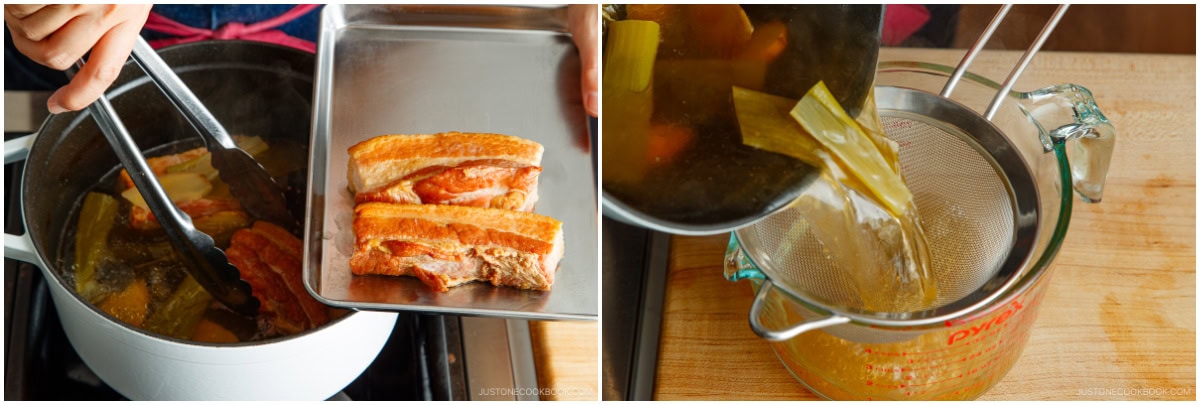
- Gently cut the pork belly into 2-inch (2.5-cm) pieces. The pork should be very tender by now, so handle carefully. Place the pieces in a single layer in a medium, heavy-bottomed pot (I use a 2.75 QT Staub). Tip: Use a medium pot for a tighter fit so the seasonings will completely cover the meat. If you use the same large pot as before, you may need to increase the amount of seasonings to cover the meat.
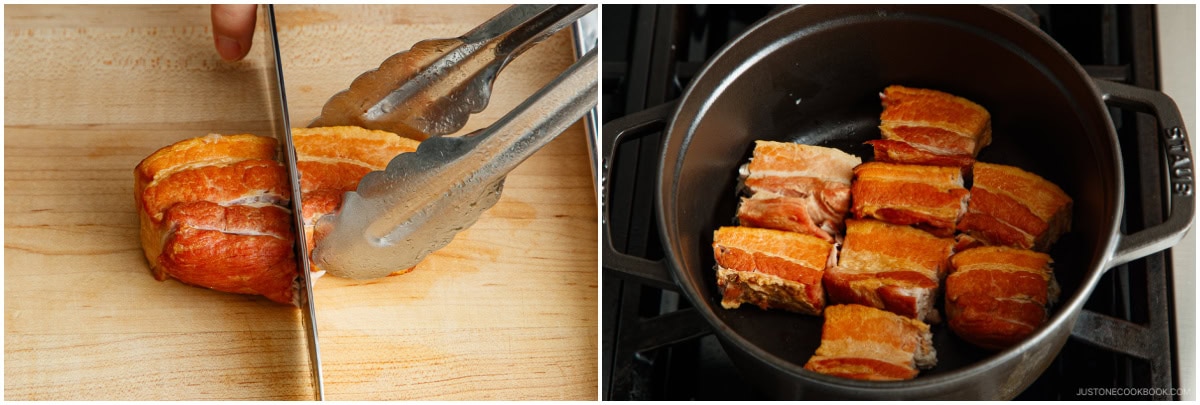
- Cut 1 dried red chili pepper (optional) in half and discard the seeds. If you like it spicy, you can include the seeds.
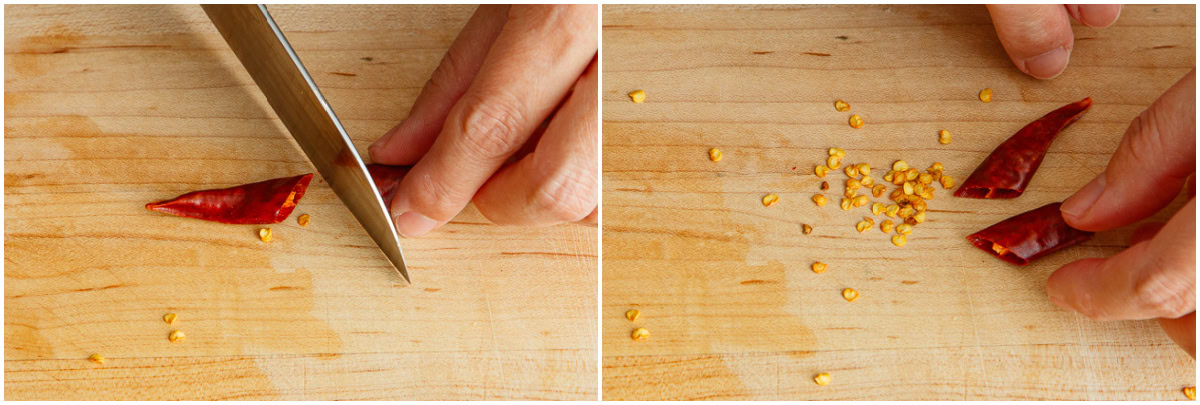
- Add 2½ cups dashi (Japanese soup stock), ¼ cup sake, ¼ cup mirin, ¼ cup sugar, and the dried red chili pepper.
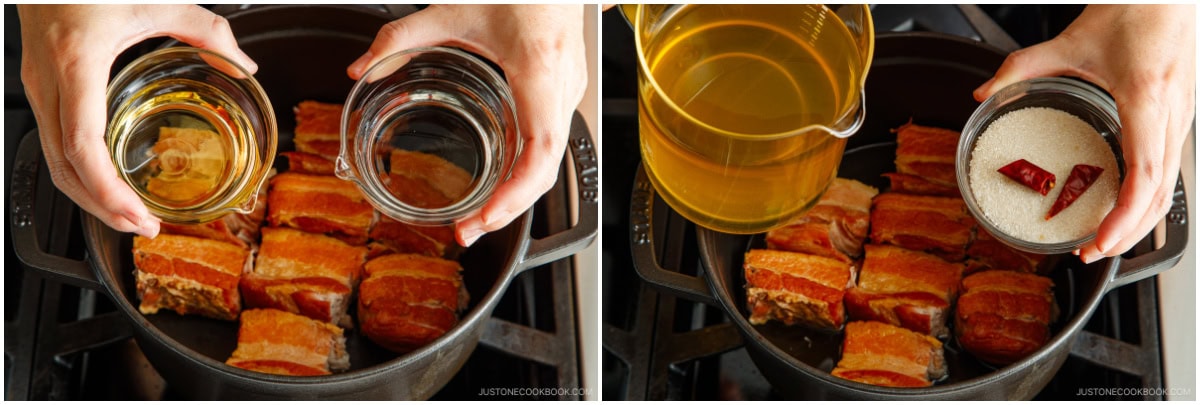
- Add the rest of the ginger slices and place the otoshibuta (drop lid) on top. Do not cover with the pot's lid. Start cooking on medium heat. Once simmering, reduce the heat to low or medium low and cook, uncovered, on a gentle simmer. Set a timer for 1 hour.
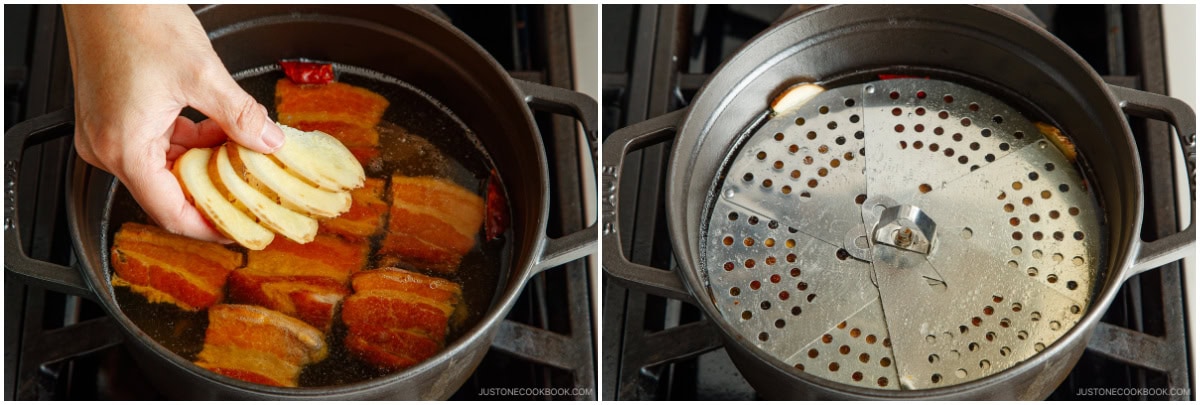
- At the halfway point (30 minutes), add ¼ cup soy sauce. Tip: We add the soy sauce later on to keep the meat from cooking in it a long time and becoming salty.
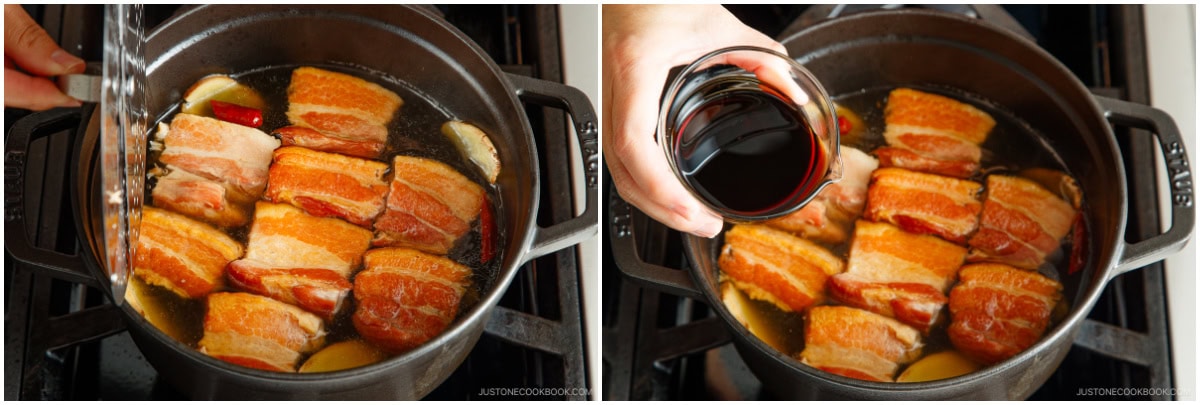
- Add the peeled soft-boiled eggs to the pot. Place the otoshibuta (drop lid) on the meat and continue simmering, uncovered, for the remaining 30 minutes.
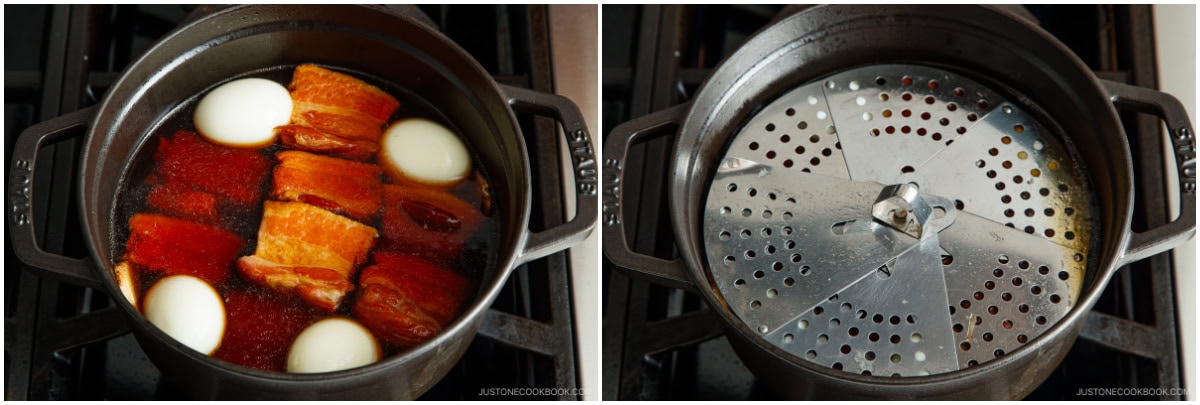
- If the cooking liquid gets low, reduce the heat to low (your stove's lowest setting). Occasionally, shake the pot to coat the meat and eggs with the braising liquid. Make sure there‘s enough liquid in the pot so the pork and eggs don‘t burn. It should be plenty of liquid; if your liquid is low, you might have been cooking on higher heat. After braising for 1 hour, turn off the heat. It's now ready to serve.
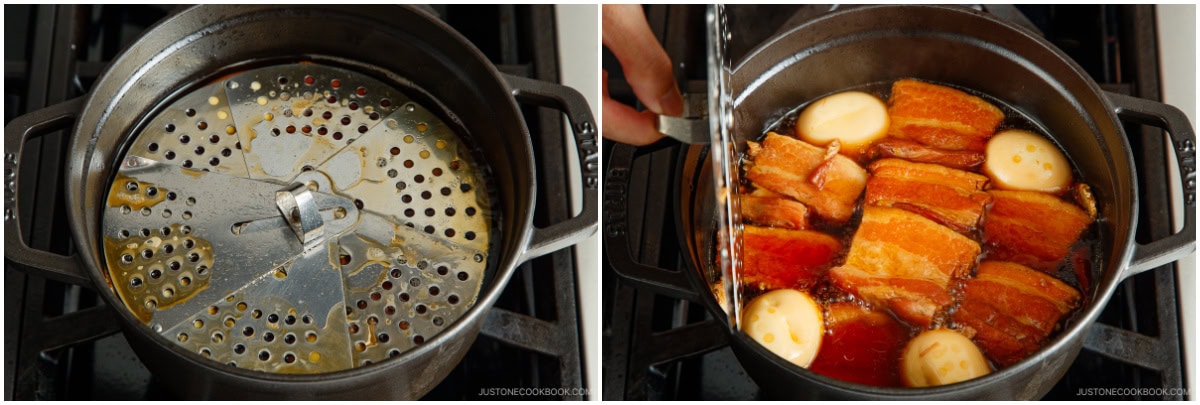
To Serve
- Use the white part of 1 Tokyo negi (naga negi; long green onion) to make shiraga negi. First, cut the white part into pieces that are 3 inches (7.6 cm) long. Then, make a lengthwise incision to remove the soft green core (save it for another use). Stack the outer layers, holding them flat against the cutting board, and slice lengthwise into very thin julienned strips. Soak in a bowl of iced water for 5–10 minutes to remove the bitterness, and drain well. Tip: For step-by-step photos, see my tutorial on How To Make Shiraga Negi.
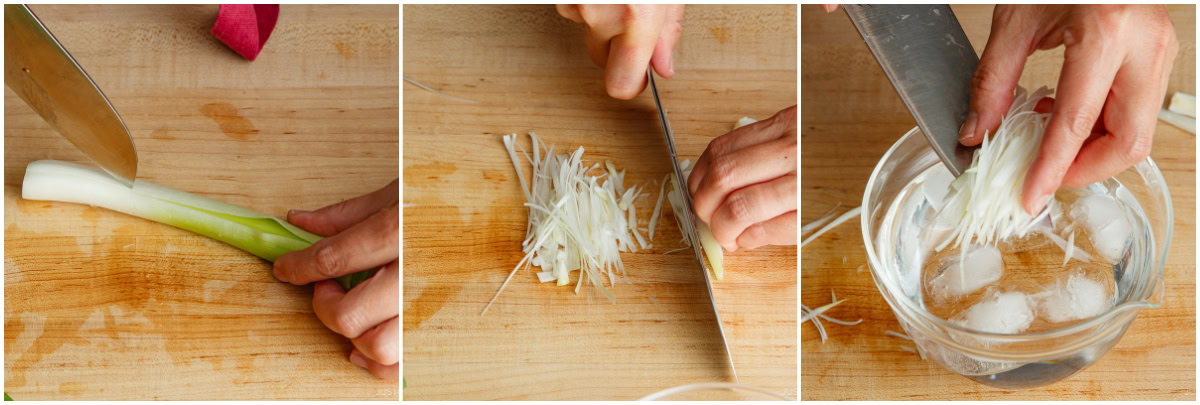
- Serve the Kakuni, eggs, and snap peas in individual bowls. Drizzle with some braising liquid and garnish on top with shiraga negi. Season with optional shichimi togarashi (Japanese seven spice) for a spicy kick.
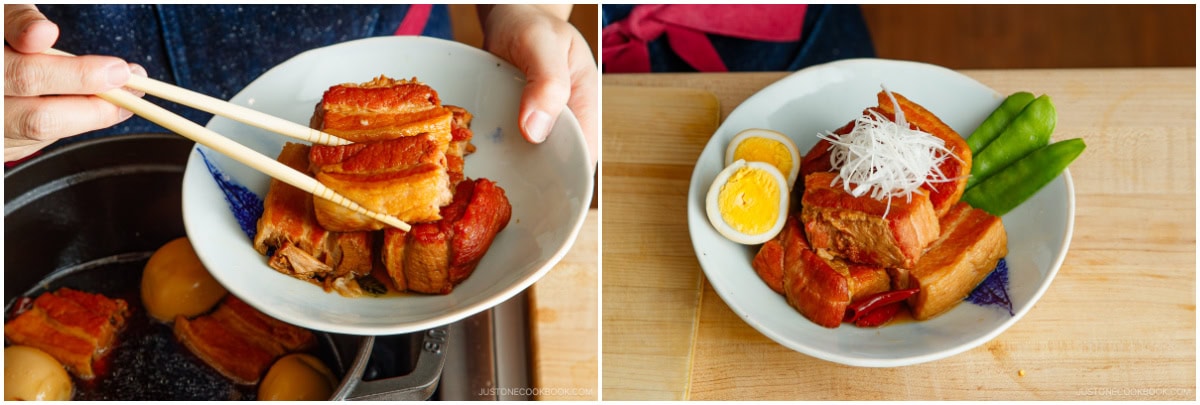
To Develop More Flavor (optional)
- For a more flavorful Kakuni, wait several hours before serving. Kakuni tastes best when gradually cooled in the braising liquid, allowing the food to absorb more flavors. Gently reheat thoroughly and serve. If you prefer a less oily Kakuni, serve it the next day. Let it cool completely, then refrigerate the pork belly in its braising liquid overnight. The next day, remove and discard the solidified fat. Gently reheat the Kakuni thoroughly and serve.

To Store
- You can keep the leftovers in an airtight container and store in the refrigerator for up to 3–4 days and in the freezer for a month.
Nutrition
Editor’s Note: This post was originally published on December 11, 2012. It was updated with a slightly revised recipe and new images on May 14, 2024.
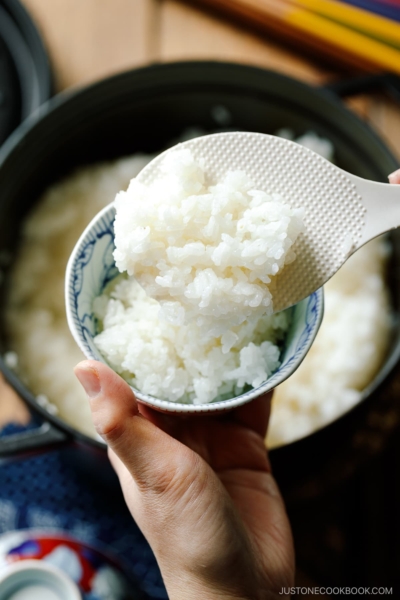
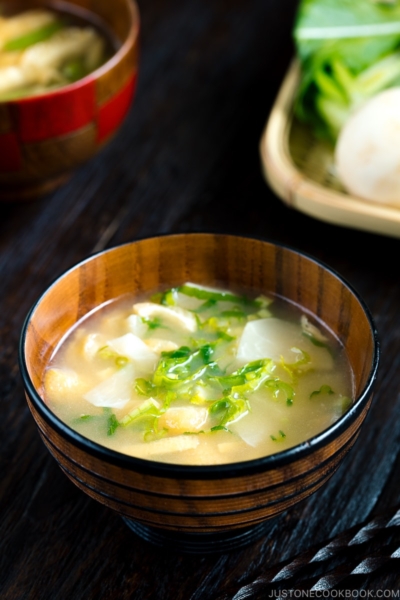
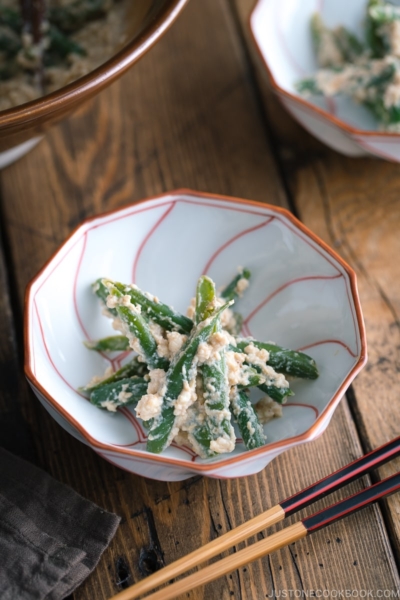
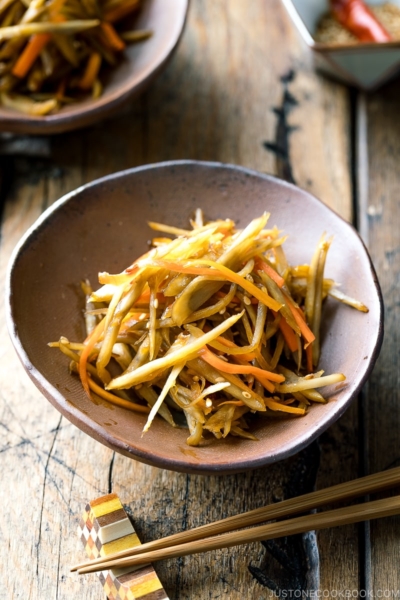




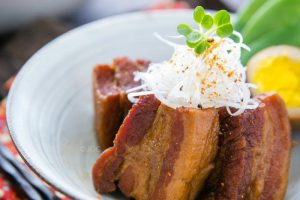
Such a simple recipe to make a spectacular dish and for meal prep too !! Oh dear it was so delicious. It melts in ur mouth like butter with all the slow cooking. Highly recommended!
Hello there! We are glad to hear you enjoyed the dish!
Thank you for trying Nami’s recipe and for your kind feedback. Happy Cooking!
This recipe took a long time from start to finish, but WOW were the results spectacular! Melt in your mouth tender deliciousness. I used a kombu and scallop dashi and served the kakuni with roasted vegetables in a Hokkaido style soup curry broth with turmeric rice. It was unbelievably good. Next time I’ll make more so I can keep some in the freezer!
Hello Ella! We are glad to hear you enjoy this dish!
Thank you for trying Nami’s recipe and for your kind feedback. 🤗
Hi I’m planning to cook kakuni very soon and I don’t have ginger available right now i wonder if onions are good replacement ? Or should i try other things? Thank you
Hi, Natasha! Thank you for trying Nami’s recipe.
We highly recommend using ginger for the best flavor, but if you are unable to use it, you may substitute 1 teaspoon vinegar.
We hope this helps!
I will try it next time! This time I accidentally found leftover ginger so i added them. It turned out great! Pork belly was soft and all but the meat part was not as soft as the fat part. Do you have any suggestions?
thank you so much
Hello, Natasha. We’re glad you enjoyed the dish!
When purchasing pork belly, we recommend selecting the higher marbling meat section cut. You might also try cooking them longer.
We hope this works for you.
Will do! Thank you! 🙇
You’re very welcome!
I made this for the first time and was a bit worried I would make a mistake and it would turn out tough. I used my steamer basket as a drop lid. Luckily it turned out amazing! So tender we could cut it with a spoon.
I served it over rice with some pickled red cabbage and miso butter mushrooms (also your recipe) and it was delicious. I love your recipes, thank you for sharing. 🙂
Hello, Abby! Aww. We’re pleased to hear you tried this dish and enjoyed it!
Thank you so much for enjoying Nami’s recipes and discovering new dish! Happy cooking!🥰
My partner has resorted to licking out the saucepan and trying to steal the leftovers, he likes this so much. The pork is wonderfully soft and the sweet and salty flavour is wonderful. Will make a bigger batch next time.
Hi, Cat! We are so happy to hear you and your partner enjoyed Kakuni!🥰
Thank you for trying Nami’s recipe and providing feedback. Happy Cooking!